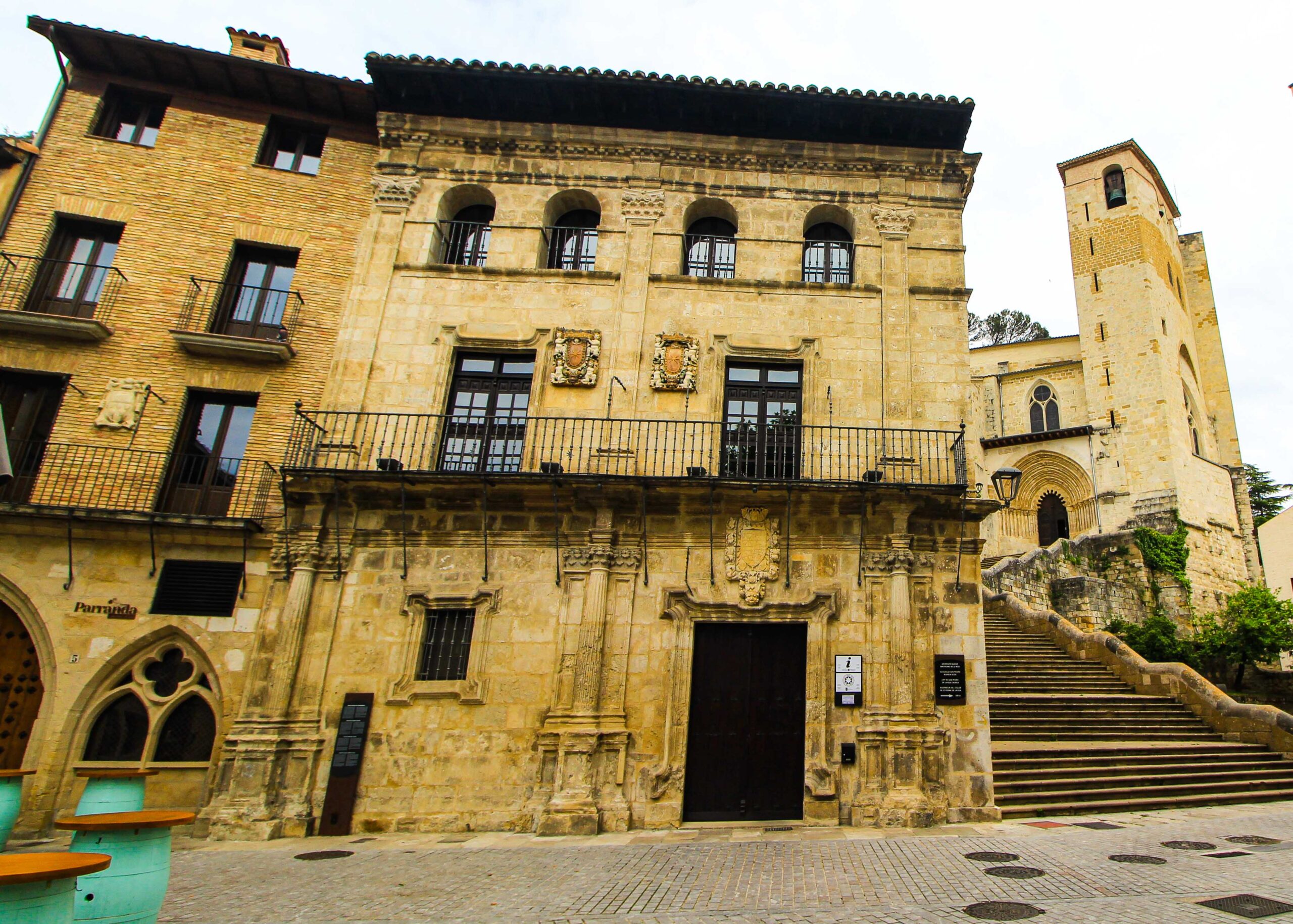King Sancho Ramirez founded the town of Estella, purposefully, along the Camino de Santiago in the 11th century.
King of Aragon, he was also crowned King of Pamplona by Navarrese noblemen after the reigning Sancho IV was murdered by his siblings.
Sancho V’s wily decision, cashing in on the building and brewing activity of Benedictine monks further up the road at Monasterio de Irache, ensured a prosperous centre of hospitality and trade was quickly established and ennobled.

Today Estella proclaims itself the ‘Medieval Star of the Camino’ and its beautiful, tiny historical centre is packed with stone palaces, churches and monasteries that feature elaborate stone carvings, heraldry, coats of arms, balconies and ancient wooden doorways.
At the end of a hot day working from the van, we wound our way through the narrow quiet streets and up to the church of San Pedro de la Riva. Its cool interior was a balm for hot skin and eyes as gentle white light flooded across its plain limestone walls. Small patches of plaster bore traces of delicate colours of faded, Medieval frescoes.

Taking a modern glass lift down the steep hillside to the flowing Rio Ebra, the intriguingly named Palacio de los Reyes de Navarra is the only surviving example of secular Romanesque architecture in the province of Navarre. It’s without any record of Sancho V or any later monarch staying there.
Bodegas Irache at the Monasterio de Irache is the sole winery along the Santiago Camino and, fittingly, it offers pilgrims a free glass or two.


Every day 100 litres of Tempranillo is poured into the stone fountain that dispenses it to the roughly 300,000 thirsty peregrinos passing by, every year. Meeting and recording them, Our Man in Estella discovered that by 4pm the Fuente del Vino had run dry, so it’s a matter of luck or timing to ensure your thirst is quenched.
He did, however, have better luck the next morning at 1030 when he joined a group of pilgrims from South American and Asia at the fountain.

The monastery has always been occupied and its complex is in preserved in excellent condition.
It includes a 12th century church and cloisters built in the decorative Plateresque style, a tower and a Spanish Baroque building that served as a university until 1824.
Three million bottles of wine are stored on site and its Bodegas Irache label is internationally renowned. It was an odd combination to see wine collectors fill their cars with boxes of Crianza and Reserva, whilst those with backpacks were sipping from the fountain around the back.

We were keen to revisit the neighbouring province of La Rioja and drove southwest onto its hilly plain, a valley formed by the wide and curving Rio Ebro.
The territory, one of the smallest in Spain, was first controlled by the Romans who established the early, eponymous vineyards. Visigoths and later the Muslims of Al Andalus claimed La Rioja before its reconquest by Christians in the 10th century.
In contrast to our visit of four years earlier, the rolling landscape of vineyards was green with verdant growth above the deep red of its limestone and clay-rich soil.

Arriving in Logrono, the capital of La Rioja, we traced our earlier and lonely steps into the historical centre. Then awash with torrential rains and under black skies, we had the cathedral, central square and winding lanes of the tapas district, Calle del Laurel, to ourselves.
Now we found ourselves caught up and bowled along in a thronging mass of people, moving determinedly into the centre, the streets of which were decked in colourful Medieval style banners and bunting. It was a festival weekend!


Held annually in June the Fiesta de San Bernabe celebrates the city’s Patron Saint around dates which handily coincide with an historical siege of the city and routing of the occupying French-Navarrese army. Arriving on a Friday we pondered that the festivities had begun early, as men and women in leather jerkins and elaborately embroidered gowns mingled amongst us.
Ducking into a tiny bodega to escape the press (and taste the pressings) we found out that it was a bank holiday, unique to Logrono, and ‘en honor a la region de La Rioja’ handily bolted on to make the festival a three-day weekend.

We treated ourselves to three wine tastings of local varieties of Crianza and were joined by a charming German couple Holgar and Susannah. Parting after an enjoyable hour chatting together, we again joined the swell, this time moving between the narrow streets of the tapas quarter now in full swing at 8pm.
The maze of tiny bars and eateries were overflowing with people cheerfully clutching glasses of wine or beer and platters of cooked and cold meats, cheeses, tortilla, fried potatoes, fish kebabs and garlicky mushrooms.

The air was thickening with smoke from wood fired grills and the blast of deep fat fryers added to the heat of the evening. We were hunting, without luck, for a bar famed for its grilled prawns when we bumped happily into Holgar and Susannah, looking for the same. Susannah had a map.
With the benefit of German assertiveness and planning, we soon had a platter between us and spent the rest of the evening with them meandering and munching our way around the increasingly noisy quarter, before saying farewells at midnight.











